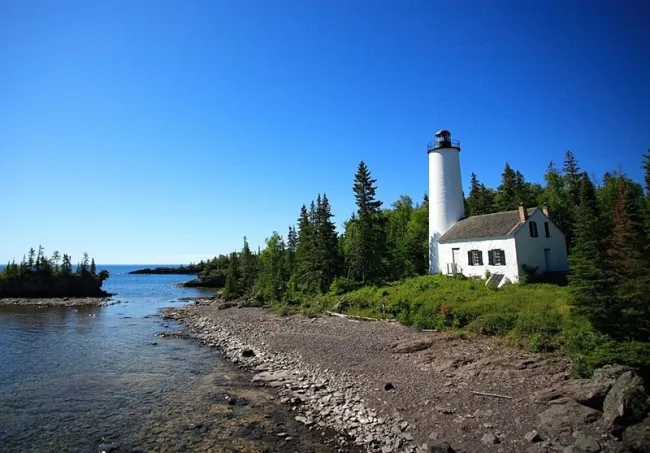
Isle Royale National Park, located in the northwest corner of Lake Superior, Michigan, is one of the most remote and least visited national parks in the United States. Known for its rugged wilderness, beautiful waterways, and rich biodiversity, the park covers a main island, Isle Royale, along with over 400 smaller surrounding islands. It offers an ideal escape for adventurers seeking solitude, natural beauty, and opportunities for hiking, kayaking, and wildlife watching.
History of the Park
Isle Royale has a long history of human interaction, beginning with Native American tribes who used the island for copper mining. European settlers later mined copper on the island during the 19th century. In 1931, Isle Royale National Park was officially established, becoming a protected area to preserve its unique wilderness. The park's isolated nature has made it an essential site for studying ecosystems, notably the predator-prey relationship between wolves and moose.
Main Features
Isle Royale's main features include dense forests, scenic shorelines, inland lakes, and wetlands. The park is renowned for its wildlife, including moose, wolves, beavers, and numerous bird species. Boating and kayaking are popular due to the many inland lakes and waterways that interconnect the islands. The Rock Harbor Lighthouse, historic mining ruins, and the park’s varied ecosystems are also key attractions.
Types of Trails
Isle Royale National Park offers over 160 miles of hiking trails, ranging from short, scenic day hikes to challenging multi-day backpacking treks. The Greenstone Ridge Trail is the most famous and runs the length of the island, offering panoramic views of Lake Superior. Other popular trails include the Minong Ridge Trail, Feldtmann Lake Trail, and shorter hikes such as the Stoll Memorial Trail and Scoville Point.
Crowd Expectations and Annual Visitors
With its remote location accessible only by ferry, seaplane, or private boat, Isle Royale is one of the least visited national parks, despite its vast size. It typically receives fewer than 25,000 visitors annually, providing ample opportunities for solitude and quiet exploration. Visitors are encouraged to plan ahead due to the limited access to the island and the need for ferry reservations or other transportation options.
Accessibility for Seniors and Wheelchairs
Due to its rugged terrain and remote nature, Isle Royale poses challenges for accessibility. Most trails are not suitable for wheelchairs or those with mobility issues. However, Rock Harbor, the main entry point for many visitors, offers some accessible facilities, including the visitor center. Seniors in good physical condition can enjoy less strenuous hikes and boat tours around the island. Still, it's advisable for visitors with accessibility concerns to contact the park in advance to discuss options.
Park Amenities
Isle Royale offers basic amenities, including visitor centers at Rock Harbor and Windigo, which provide information, maps, and educational exhibits. Limited dining and store facilities are available at Rock Harbor and Windigo, where visitors can purchase supplies and food. However, due to the remote nature of the park, visitors are encouraged to come prepared with their own provisions.
Camping Facilities
Camping is the primary form of accommodation in Isle Royale National Park, with 36 campgrounds scattered across the island and its surrounding islets. Most campgrounds are accessible only by foot or boat, and they offer primitive facilities such as shelters, outhouses, and fire rings. Reservations are required for groups, but individual campsites operate on a first-come, first-served basis. Backpacking and canoeing between campgrounds is popular, offering an immersive wilderness experience.
Access to Lodging
For those who prefer more comfort than camping provides, the Rock Harbor Lodge offers rooms and cabins for overnight stays. This is the only non-camping accommodation on the island, and it provides easy access to hiking trails, boat rentals, and guided tours. Due to its limited capacity, reservations are highly recommended.
Pet-Friendliness
Pets are not allowed on Isle Royale National Park, which is a policy in place to protect the island's fragile ecosystem and wildlife. Visitors must plan accordingly and leave pets at home when traveling to the park.
Best Months to Visit
The best time to visit Isle Royale is during the summer months, from mid-June to September. During this period, the weather is warmer, and most park services, including ferries and the lodge, are operational. July and August are the peak months, offering the best conditions for hiking, camping, and water activities. The park closes in the winter due to harsh weather and difficult access.
Conclusion
Isle Royale National Park offers a truly unique and remote wilderness experience for those looking to escape modern life and immerse themselves in nature. With its rich history, diverse ecosystems, and opportunities for solitude, it’s a hidden gem among the U.S. national parks. While the park may present challenges for accessibility and requires careful planning, the rewards of exploring this pristine island make the effort worthwhile. Whether you’re a hiker, kayaker, or wildlife enthusiast, Isle Royale promises an unforgettable adventure.



